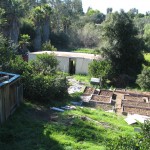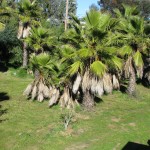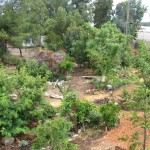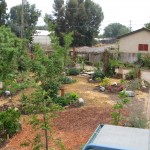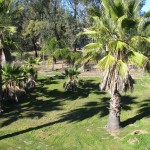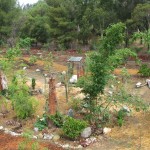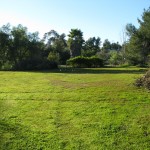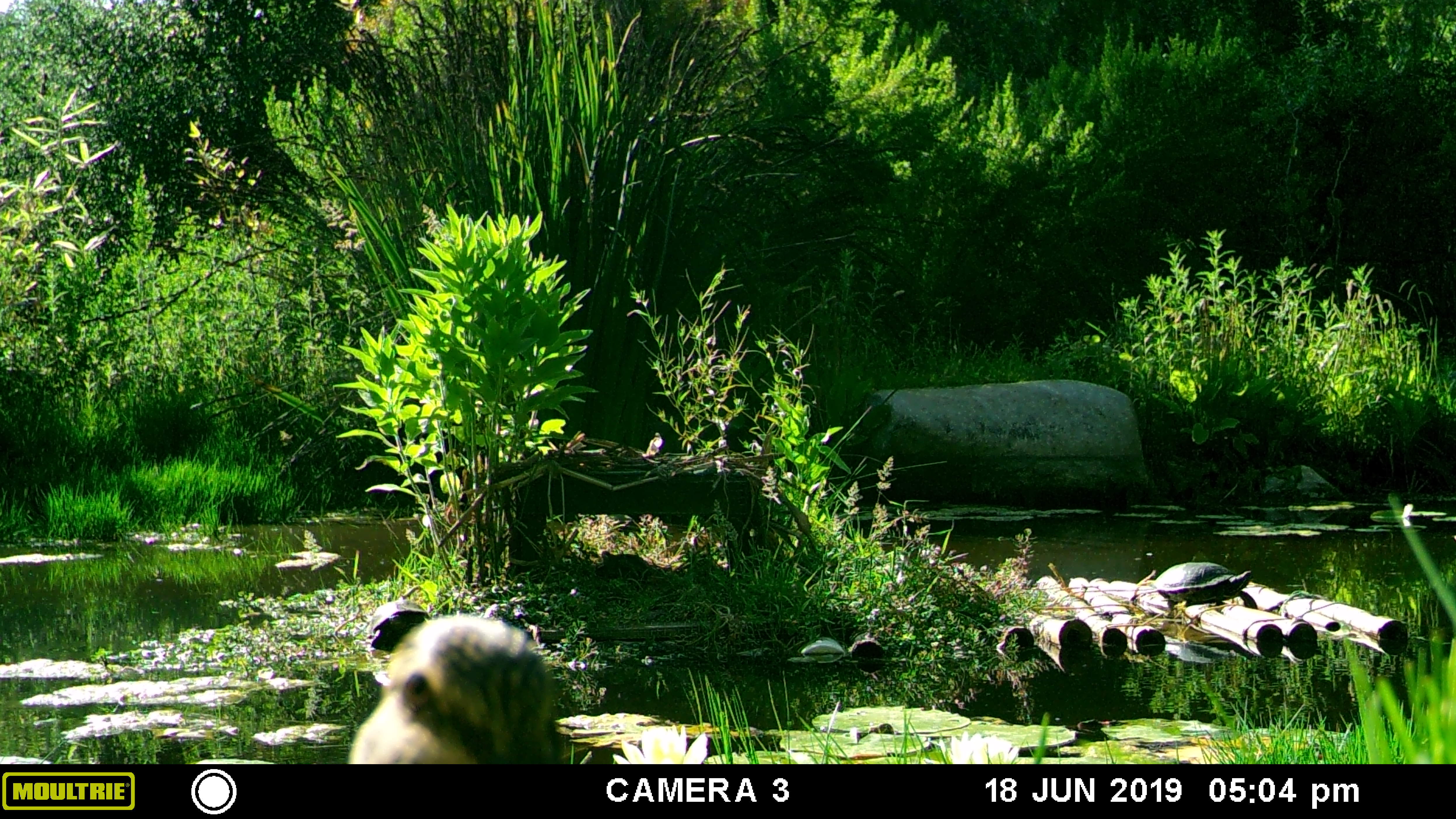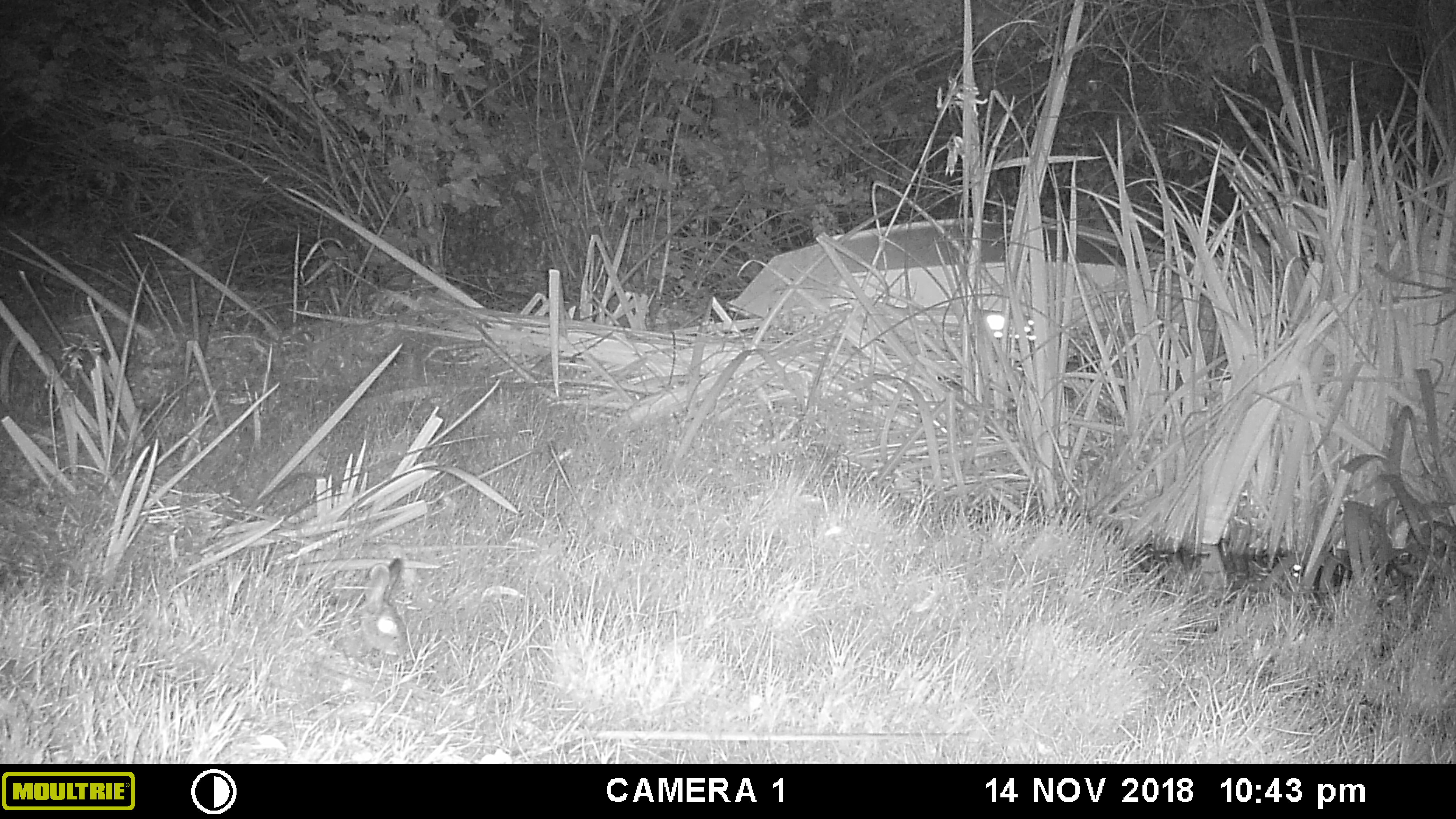-
Dedicated to Evelyn

Almost time.... We’ve gathered seven eggs from the girls this week. We believe the first one was Evelyn’s, the beautiful blond Buff Orpington. The next ones are Miss Amelia’s, followed by a blue/green one from Chickpea and unbelievably, a brownish one from our other Americauna, Kakapo.

First three beautiful eggs, L-R Evelyn's, Miss Amelia's and Chickpea's The two Barred Rocks are too young yet to lay, but they certainly are interested in what is suddenly so popular about the nesting boxes.

The Barred Rocks are curious teenagers The nesting platform in the chicken tractor isn’t deep enough to keep straw from being kicked off, so I’ve put up three bee ‘supers’, which are four sides and no top or bottom. Until something else can be arranged, they do just fine.

Miss Amelia, tail up and ready to get it over Watching the girls as they become hens has been interesting. Miss Amelia sat in the nesting box and panted.

As a mom, I know how she's feeling. She allows me to pet her now, as she squats into the mating pose. It is a little disturbing, and doubtlessly frustrating for both her and Emerson who is caged separately.

Miss Amelia is desperate for... attention. Sorry! Chickpea, the big girl, jumps from box to box annoying everyone trying to nest in there. She kicks as much bedding out as she can, sending it flying across the coop with her big feet. When she’s ready to lay she goes into a chicken trance. You can wave your hand in front of her eyes and there is no response, just some panting. Then, voila! A beautiful greenish egg.

Chickpea in a trance Kakapo is the nest builder. She’ll squat down in one of the boxes then lean her head far out of it, almost losing her balance, to grab a wisp of straw to throw over her shoulder into the box.
We hadn’t seen Evelyn lay, but assumed the first egg which was pointier than Miss Amelia’s, was hers. She’d been in a mood for several days and had settled down. Yesterday, though, she sat down in the corner of the pen by her beau Emerson and took a nap in the daytime which was uncharacteristic. She appeared perfectly healthy; in fact, I commented on how red and full her wattles were. This morning we found our dear Evelyn dead on the floor in the corner of the coop. We also found two eggs with transparent shells in the lay box. There was no evidence of what made her die, but I’m guessing it had something to do with the egg-laying. We don’t know who laid the shell-less eggs, but that shouldn’t kill anyone. It is remedied with more calcium in their diets on top of their lay pellets. Perhaps she was egg-bound, or just couldn’t handle the eggs. We were horrified and greatly saddened. I buried Evelyn under the lime tree just behind the coop. Now we have five hens and a rooster. We gave the girls crushed egg shells and kale leaves, and I’ll sprinkle calcium on their food tomorrow. We’ll miss the beautiful Evelyn something terrible.

Evelyn looking great. No signs of illness. -
Stinkhorn!

What is that? There was a surprise in our garden this afternoon. We were weeding and planting a flower seed mixture around the back of the house, and suddenly my daughter excitedly shouted, “Stinkhorn!” I didn’t take offence. I was excited, too. What she was referring to was a reddish, odd-looking fungus that had emerged from the ground next to a rose bush. This fungus makes a rather unpleasant odor, which attracts flies who then carry off the spores. A pretty tricky plant. We had our first and only stinkhorn emerge last year in a different part of our yard, and I was afraid that with all the walking and weeding done in that area, that it wouldn’t be back. Silly me. The fungus was traveling!

Flies enjoying the stink and spreading the spores Then shortly after this discovery and only a few feet from it, I was digging up weeds and found what I thought was a reptile egg. We thought that maybe it was an egg from Mrs. Sabatini, the Western pond turtle that we found on our property and released into our upper pond, never to be seen again. Or perhaps a snake egg.
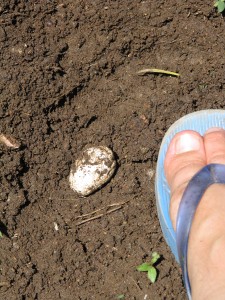
Not a reptile egg When I felt it, however, it was firm and had a little give to it, like it was made of soft rubber. My daughter figured it out. She had read where the stinkhorn spores grow into an egg-shaped, um, thingy, which breaks open underground revealing the slimy gooey part which then pushes up through the ground and begins stinking. The slimy part has the spores on it.

The shiny green interior will thrust out of the ground Fungus is incredible and wonderful. The threads of fungus hold together the soil, feed us, medicate us and yet we know so little about them. An incredible book to read is Mycelium Running: how mushrooms can help save the world, by Paul Stamets. Although most people wouldn’t welcome a stinkhorn into their perennial border, we think it is very cool, as long as there aren’t too many of them!
-
A Little Brown Gift (and it isn’t what you might imagine)
Yesterday’s blog post was my 100th posting. I was wondering what kind of post I should write to celebrate, when my animal family took the decision right out of my hands… and put something else back into my daughter’s hands that was cause for celebration:

Egg! I had just been reminding the girls (hens) that their egg-laying should commence in August, and since they didn’t have a calendar in their coop, what the date was. This afternoon I stepped into their coop to fill their food dispenser, and saw the first egg! So small and so perfect. We aren’t sure whose egg it is, except that it doesn’t belong to Chickpea or Kakapo the Americaunas because they will lay blue and green eggs. Our bet is on Evelyn because she was squawking a lot this week, and since she’s at the top of the pecking order, perhaps she felt that it was her duty to lay first and impress her beau Emerson. Emerson is separated from the girls by chicken wire so that he may keep company, albeit frustrated company, with them. We separated him just in time to not have fertile eggs!

Kakapo wondering how to eat it So the egg is in the refrigerator, the nesting area is replete with straw, and we are eagerly awaiting more eggs. Miss Amelia was showing signs of being disturbed about something. Passing the first egg would be quite uncomfortable, I’m sure. As a mother of two, I’m actually positive about that. Chickpea – who reminds me a bit of Meryl Streep playing Julia Child – was determined to kick all the straw off and bother her, so maybe tomorrow. What a great little brown gift!

Kakapo and Miss Amelia looking at egg -
Reading to a Fault

The Library: Cookbooks, Non-Fiction, Reference (including the complete 22 volume Oxford English Dictionary), and Fiction (Not shown are Christmas books, health and gardening books and some favorite children's books) I need to confess: I read. Perhaps all of you are nodding, thinking that you, too, read. I’m very glad of that. However, my confession is something along the lines of AA. I read to a fault. I read between 3 and 5 books a week. Yes, all of them are over 200 pages, and no, none of them have embracing couples on the front. I read myself to sleep. I read myself awake sometimes. I’ll take a break in the afternoon and read, and wind up several hours later with very angry cats nagging me for their dinner. I have a stack of bedside books, books in the library, a book in each car in case of emergency. I’ll read until I have less than half an hour to wash, dress, feed animals, grab food and drive somewhere. I have read long through the night when I have needed to be up in the morning early.
I feel sometimes that I’ve been consumed by the books.

Living room: Humor, Do-It-Yourself and Old Books I read too quickly. I could not recite the plots and names of the characters in the books that I read, and that is a major fault. I have a good friend who reads steadily and slowly, and can call to mind all the characters and all the plot points in all the books that he has read. I envy him that.
I read mostly fiction, but I always keep at least one non-fiction going at all times. I particularly enjoy well-crafted and researched historical mysteries. I have learned more about the history of the world, the nuances of human struggles and the colossal efforts to survive in the face of war, disease, political and religious oppression, starvation and exhaustion, than was ever even hinted at in any of my schooling. For instance, the Sister Fidelma mysteries are written by historian Peter Tremayne and concern the changeover from the ancient Celtic traditions to the strict and woman-hating traditions of the newly approved Roman Catholic Church in 7th century Ireland. In the Celtic world, women could be judges, teachers and could own property. There were universities throughout Europe. The Picts were still present, and their written word Ogham took the form of slashes on sticks, which were bundled together to form long documents and hung on walls to form libraries. The first witch hunts began when the Roman Catholics wanted to obtain land and power from the women and subjugate them. A man who proved a woman a witch could have her property and belongings, and the tests for being a witch were hard to survive (drown and you are innocent, float you are a witch).
From C. J. Sansom’s Mathew Shardlake series I learned about 16th century England and just what the dissolution of the Catholic church meant for the monks and the parishioners, and how life must have been like under a king who regularly took young wives, and had them killed when they didn’t produce a son.

Bedroom Part One: Series, storytelling, folklore and fairytales, some reference. From Anne Perry I’m learning about Edwardian and Victorian England, the oppression of women, of the poor, of the inadequacies of the medical practice (they just discover chloroform so that operations can take a little longer, although most patients died of infection afterwards, anyway). About the threat of disease from the lack of sewers and the incredible labors it took to build the new sewers, and new railroads.
Elizabeth Peters has shown me Egypt at the turn of the century, in a series of mysteries that are as funny as they are educational. The Amelia Peabody series is priceless; three of our chickens are named after characters in those novels, so you can see how important it is to us! (Emerson, Miss Amelia and Evelyn).
In non-fiction I prefer travel writing. I’d love to travel the world, lingering in each place to absorb the language, the customs and the landscapes. If only I could do that while also staying at home! Travel writing allows me to vicariously see the fascinating corners of the world without suffering from airports, taxis, buses and car rentals, or trying to find vegetarian meals in a meat-loving place. I enjoy some Paul Theroux, Freya Stark, and many more who have helped me cross Africa on foot, hike through Tibet sipping hot tea with goat butter, fight the overwhelming fecundity of the sweltering, buggy Amazon rainforest, and sail through terrible storms and dead calms.
I also love to read non-fiction about animals, such as the books written by Gerald Durrell, or about wolf re-introduction (thanks, J & J!), or what survives in extreme weather. And about gardening and the love of nature and home such as Sue Hubbell’s A Year in the Country.
There is also satire such as Terry Pratchett’s Discworld series. Incredible writing, a double-take kind of humor that makes you love your fellow man as you laugh at and with him.
I remember the first book that I read alone when I was five. It was a collection of fairytales. I still have it although it looks much smaller now. I remember getting through it the first time and feeling so accomplished, and then reading it again and realizing how quickly it went. Little did I know that I would be a slave to the written word from then on. My parents read when they could, and greatly supported reading. We’d attend the Carlsbad Library Book Fair, and I’d always order thin, wonderful books from the Scholastic Book Fair at school. I loved Sherlock Holmes, Agatha Christie, Tolkein, and The Three Investigators (so much better than the Hardy Boys!). I worked at B. Dalton Booksellers on the El Camino Real mall, then met and married another book lover who was a manager there. He became a book scout and I was once again going through stacks of books at sales again, trying to find treasures. After a divorce and a career as a Park Ranger I became a middle-school librarian for eight years. Heaven! All those old favorites, added to purchasing books at a time when young adult literature was exploding. So many well-written and well-researched, imaginative books! I still follow young adult authors because what they write is often so much more rewarding and intellectually stimulating than popular fiction. In fact, some of my go-to fiction when I need something familiar and comforting is from the young adult genre. Tamora Pierce and Sharon Shinn, to name a couple.

Bedroom part two: Reference on Writing, several complete series, and misc. In room behind is poetry and art, as well as all my daughter's books. And there are more books in other rooms, and in boxes in the garage, and in a stack next to my bed. I’ve never been a bestseller-list follower, nor a lover of award winners or book club choices. I have had almost-conversations with women who are also good readers, and we have almost no books in common. A couple of notable exceptions have been the Guernsey Literary and Potato Peel Pie Society by Mary Anne Shaffer, and finished by her daughter-in-law Annie Barrows when the author was ill, and the Ladies No. 1 Detective Agency series. The former because it is warm, humorous, and yet describes the horror of living on an occupied island during WWII. The latter because it exposes a completely foreign (to me) way of life of a village in Africa and the warmth, simplicity and traditions of the people there. Both of these make me feel warmly towards the human race, which is something I need encouragement to do. Books that dwell on hopelessness, horror, unrelieved pain and despair, I just won’t give a time of day to. Also those mysteries that are violent and graphic for the sake of selling copies. No, thank you. Just keep my mind working and my interest peaked, thank you.
So I read and read. Have I mentioned audiobooks yet? They are on top of the reading books. At one point I had an audiobook for the car, one for the house, and one in the wings just in case. I usually have one or two in the car now. I listen to audiobooks of authors I probably wouldn’t sit down to read, or of books that are deemed important, award-winning or classic that I’ve either read and forgotten about, or never read for one reason or another, such as Pulitzer prize winners. There are audiobook readers who are superb at what they do, such as Barbara Rosenblat, and some where I’ve had to shut the audiobook off because the reader was so terrible. Usually authors really mess up their own work, so I try and avoid those. I’ve had audiobooks playing in a CD player attached to an extension cord out in my yard so that I could listen while weeding. The problem with that is you can’t easily leave the area even for a second because you’ll miss something, and your hands or gloves are too dirty to touch the CD to pause it. Areas of my yard have an afterglow of memory of the audiobook I listened to when I was working their: my side yard is very much the 1100s in Shrewsbury, England on the border of Wales where Ellis Peter’s Brother Cadfael is grinding herbs and solving mysteries. My backyard has a memory of the cold sea from listening to Anne Proulx’s The Shipping News.
I volunteer at the Fallbrook Library bookstore The Bottom Shelf once a month or more (there are set times and I’m also on the fill-in list). Three hours guaranteed guilt-free shopping in a dynamic used book store: dangerous! So many incredible books! Old friends, and new friends, and books from other countries and on topics I’d never thought of. How I love filling the shelves and keeping an eye out for my favorite authors! In come people with their lists. Decades-old index cards on keyrings that have tiny lists of titles from alphabetized authors, small notebooks, and school paper falling apart at the folds. I have my own lists carefully saved in my purse, as well as a regular notebook at home with authors and their complete works listed chronologically by publication date with notes about the series and author and how I liked them. I also post my books and some reviews on Goodreads, which is a virtual personal library list. I wish that I could remember all the books I’ve read in my life so that I can list them all and be complete. Perhaps book people are also list people. Gotta have a list. I buy books at a quarter, read them and return them. Can’t beat that.
Reading is a treat, a reward, a hobby, an education and an escape for me. I don’t watch television; I haven’t had it hooked up for about 16 years except to play DVDs and VHS tapes. I often wish that I could directly link all the books to my brain so that I can absorb them all and have all that knowledge. Oh, and have a memory that will handle it, too! I share books with my family and friends. I read aloud to my children until they were in high school, including the Complete Sherlock Holmes, all the Redwall series, most of Musashi, and stories from James Herriot, and many, many more, usually with me falling asleep while I’m reading and finishing the sentence with some garbled words my dream self interjected.
I have many faults, but few vices. I don’t drink often, smoke, or take much medicine or drugs. I may read murder mysteries but I can’t even feed a tomato hornworm to the chickens. But I read. Books, not electronic devices. I love the feel of a book. And I hope I always will.
-
Midsummer Garden
When I’m in the garden everyday, I find that I forget that only seven months ago, things looked radically different. I’ll post some before and now photos below:
View to pond, before View to veg now Out to neighbors before View to neighbors now Entryway before Entryway now Middle property before Middle property now Lower yard before Lower yard now What a difference six months can make!
-
Home Remedies
I’ve been going to physical therapy for my sprained wrist, and fortunately the therapist is someone who believes in diet and herbs as a viable alternative to or complement of conventional medicine, as do I. We started discussing home cures, and I began to think over how many that I knew because my mother used them. I was born when my parents were in their early forties, and they were born before the 1920’s, before World War II and the scientific revolution. Before everyone turned to petri dishes for the ultimate answers. Medicine made great progress in finding vaccines for heartbreaking diseases such as polio. However, its successes gave it a blanket approval, and suddenly scientists could do no wrong. Many medicines are derived from plants, such as simple aspirin which has the main ingredient salicin that is found in willow trees. Scientists found a way to synthesize salicin so as to put a patent on it and make money, just like so many other drugs. When pharmaceutical companies took hold, that is when we lost control of our traditional medicine and our health. Health is a business, and what is in the drug stores has little to do with getting well, but is mostly about making money. Most medicines treat symptoms and provide enough relief to make you re-buy the product, but won’t eliminate it because then you will have no need to buy it again.
Home remedies have for the most part become lost in the past as post World War II parents disregarded the ‘old fashioned’ methods and turned to the pharmacy. Thus, the traditions were not passed on to their children, so the remedies have been lost. Only in reading old books do we hear them mentioned. Or we can surreptitiously inquire at a health food store, where much of the same buying tactics are at play, and clerks are not medical professionals. The desperation for cures is such that people would often believe strangers rather than doctors, well-written propaganda rather than documented success, and that is dangerous. I was shopping at Henry’s last week, standing with my empty basket looking at the herbal tinctures section, and a woman pops around the corner and holds up a bottle of sesame oil and asks if it would be a good choice to use as a carrier oil for a tincture she had at home. Fortunately for her, I’ve been involved with herbs for thirty years, and I knew what she was talking about, and gave her I think accurate advice and warnings, which included doing some sound Internet research on her own. I don’t know how a short, middle-aged woman with an empty shopping basket would appear to be knowledgeable, but perhaps anyone would have done as well for her.
I have been researching home remedies for reducing inflammation, since my sprained wrist hasn’t healed and I have arthritis and bursitis (wow… just bury me now! What happened to youth?) among other casualties of the physical working life. It made me think of my mother and all the vitamins she gave us and home remedies, as well as enforcing a healthy, balanced diet when meat and potatoes were the standard.
One cure she passed on from her European grandmothers was the mustard plaster for chest colds. Mix dry mustard powder with water to make a paste, put it on an old cloth and slap it on your chest. She used old diaper cloths. I still have them! If you have tender skin or are a child, then a film of vegetable oil on the skin helps protect from the burn. I believe that the way it works is to stimulate blood flow to help the body clear up congestion, and warm up the body to help sweat out the toxins. Capsicum from peppers works the same way in arthritis medicines. Vicks Vaporub replaced the mustard plaster, using menthol from eucalyptus and mints (now synthesized) to clear the sinuses as well as help the chest. The petroleum jelly in it links us to our dependence on oil, whereas mustard grows in most places and people would harvest the weeds, using the fresh leaves for a spring tonic and the seeds for food and the mustard plaster. Another remedy was blackberry juice for.. um… the ‘runs’. It ‘binds’ the intestines quickly. She’d use a little Manischewitz Blackberry Brandy diluted in warm water, and it would not only stop the problem, but relieve the cramps and make a sick kid sleep. I’ve always used it and it has always worked, as well as plain blackberry juice. Some blackberry brandys don’t have real juice in them, so beware. There is also the cider vinegar and honey remedy which was very popular in the late 1960’s, and has cyclical resurgences. Cider vinegar is slightly fermented from apples and should have a murky, stringy bit in the bottle. That is the ‘mother’ part of the yeast which is alive, and which you can use to ferment other things if you make your own. It is also claimed to be very healthy. Mom would give us apple cider vinegar mixed with honey and warm water to drink along with dinner. I have a fondness for it, even though it brings me back to a childhood which I would rather forget. Every now and then I read about how great vinegar is and mix some up. In fact, I think I’ll do so today and see if it helps with my wrist!
Let’s see what else… prunes for.., well, the opposite of what blackberry is for. Ginger ale to settle a stomach when throwing up. The carbonation helps, but it is mostly the ginger, which eases car sickness, morning sickness, or a sour stomach. Of course, garlic, which is the cure-all to many illnesses it seems. I figure that people reeked so badly of garlic that no one would get close enough to them to give them any germs. Then there is arnica for bruises. Arnica cream is a standard in my medicine cabinet (you can learn more about them here), and when my daughter reminded me of it this week and I started applying it to my wrist at night, I had a noticeable difference in the morning. Honey for many things, including local honey for hayfever, applying it to dry skin, using it for its germicidal properties, and mixed with lemon for coughs. Raw, unheated honey kills germs and bacteria. When people had dirt floors they used strewing herbs such as rosemary and lavender on the ground when. Not only did they help with the smells of the household (which were considerable), they had medicinal properties. Rosemary kills germs. In my research for anti-inflammatory herbs, along with some Asian herbs that I’m unfamiliar with and probably can’t get, the four main common ones are garlic, ginger, pepper and turmeric. Turmeric is a yellow powder from the turmeric root and is used in curries here, but used in many medicines in India. I’m planning on creating a tincture of the four of them and applying it to my wrist to see what happens.
Of course there is always the simple Irish remedy, as is hailed on one of our traditional Irish music CD’s: ‘Have a drink of whiskey to soothe away your pains’.
If you have proven home remedies, I’d love to hear about them!
-
Pepinos

They look like white eggplants There is an unusual plant in my garden, one that I mistook for a white eggplant. Indeed, it is from the same Solanum family as eggplant, potatoes and tomatoes. The plant right now is small and has dark, shiny attractive leaves and flowers that remind you of eggplants. Then there are the egg-shaped and larger than egg-sized white fruit, which have purple striping. The plant arrived in my garden via Roger Boddaert, the landscape architect who has been working on my property, and there was no name on it. My daughter and I speculated on what the plant could be. A couple of years ago when we were traveling in Ecuador, we were usually served fruit with a sugar syrup for dessert. One of the fruits served was called a Tree Tomato. It was a local treat. It was one of the most god-awful things I’d ever put in my mouth. Thin, red bitter skin filled entirely with small hard seeds and sour pulp, it was everything we could do to eat enough of it to be polite. In our research for what this plant was, the Tree Tomato came into mind and we were apprehensive that we were now the owners of a white version of this disgusting fruit.
We were wonderfully incorrect! The plant in our yard is called pepino, or Solanum muricatum, or pepino melon, or sweet pepino, it is a South American shrubby plant with incredible sweet fruit. It is a relative of the Tree Tomato, and that only goes to show how different members of the same family tree can be! The fruit as it ripens doesn’t become particularly soft; in fact, when it wrinkles it is overripe. The fragrance of the uncut fruit is marvelous. When you open the fruit it has a small center of easily scooped small seeds, and flesh that isn’t too soft or too crunch and has a taste of a ripe melon with a hint of fresh cucumber.

A pleasant fruit with an exotic taste and fragrance The scent is intoxicating, and reminded one friend I showed it to of some elusive childhood fragrance. The perfume is even better than the fruit, but the fruit is wonderful cut up in a fruit salad. The bush itself is attractive, especially with the egg-like fruit dangling from it.

This small bush can grow up to seven feet tall Although pepinos are new to me (I’m always amazed at how many things I don’t know about, even with reading about five books a week and keeping my eyes and ears open in life), they’ve been in San Diego since the late 1800s, and are often grown in greenhouses. They’ve been eaten in the Andes, Ecuador, Peru and Chili from whence they came for so long as to appear in some artwork. If you have a spot in your yard for an unusual and highly satisfactory fruit, look for pepino. The fragrance of the fruit alone is worth it!
- Gardening adventures, Other Insects, Permaculture and Edible Forest Gardening Adventures, Rain Catching, Vegan, Vegetables
Beginning an Edible Forest Garden

Pumpkins by the chickens An edible forest garden is a mode of growing that mimicks the relationships between plants in a forest, while substituting food producing plants for humans. To achieve this, you have to examine what plants grow in forests near you. Here in San Diego County, we have chapparal communities, along with some pine and oak forests in the mountains. I cannot replicate a forest such as found in, say, Olympia, because we have completely different climates, soils, and plant interrelationships. Even for people who live in deserts, you can examine what once was there before the area was a desert, or what plants are in a nearby oasis if you have one. I’d substitute plants for more desirable ones, such as lemonade berry for its cousin poison oak. Plants should provide canopy, groundcover, mulch, nitrogen-fixing, and insect attracting. After these plant guilds mature they will provide fertilizer and moisture for themselves.
However, most of us are far away from this type of gardening, or just don’t want to go that far. Integrating your ornamentals with food plants, though, is not radical anymore and entirely practical. Any nook in your yard can be a place for food producing plants. Too many squash or tomatoes? Take them to a local food pantry.

Melons by a dead lime tree trellis 
A single Cinderella pumpkin vine under an apricot 
Zucchinis make lush bushes 
Watermelons suppressing weeds Tomatoes are a vining plant which will use any upright structure on which to climb.

Can you see the tomato plant? (Its up the palm trunk) Is your produce sprouting in the house? Try planting it instead of composting. Onions make particularly pretty plants with flowers that attract pollinators and hummingbirds. You may collect the seed from them as well. If the produce doesn’t survive, its okay: you’ve just buried compost.

Plant sprouting produce for ornamentals and to gather seed Sweet potatoes are perennial plants that produce swollen rhyzomes rather than swollen roots as other potatoes do. Plant them where you can dig up some of the roots but leave the main plant to thrive for years, depending on your climate. Their leaves are beautiful, and the plants are often sold as ornamentals.

Sweet potatoes have beautiful leaves Herbs in the shrubs, strawberries in the flowers, and melon and squash under the trees all make for a beautiful edible landscape that will provide food, compost, mulch and habitat while you study up for your edible forest garden.

Strawberries with yarrow 
Apple mint attracts pollinators and is good on fruit 
Passionvines are a host plant for Gulf Fritillary butterflies 
Hops are vigorous, tall vines for brewing and sleep pillows 
Grapes will hide a chain link fence - Gardening adventures, Heirloom Plants, Permaculture and Edible Forest Gardening Adventures, Vegan, Vegetables, Vegetarian
Scarlet Runner Beans, A Perennial Bean for Food and Beauty

Scarlet Runner Bean Seeds Scarlet runner beans (Phaseolus coccineus) are beautiful plants that are easy to grow, and are often grown just for their red flowers.

Use taller stakes than I did! A trellis or 8-10′ pole is necessary because the vines wind their way up high.

Eat green beans when small They produce a broad bean that can be eaten very young when green, or allowed to dry and the seeds harvested for storing and cooking later.

Shell the pods to store in a dark, cool place The seeds are a spectacular purple and black, making this whole plant ornamental. Cook the seeds before eating them.

Beautiful purple and black seeds The entire plant is also edible, including the starchy roots. The flowers and young tendrils dress up a salad. Although the vine will die down for the winter, the roots will live on in areas where they won’t receive heavy frost. They are native to many places in South America and have been harvested for hundreds of years. This is a perennial bean which will live about six years with care. It is also a nitrogen-fixer, which is excellent for your soil. How fantastic is that?
- Gardening adventures, Permaculture and Edible Forest Gardening Adventures, Recipes, Vegan, Vegetables, Vegetarian
Kale Chips
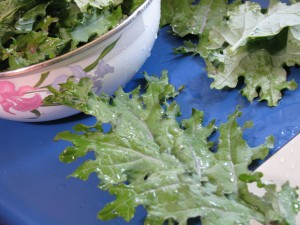
Purple kale You may have heard about these already; they seem to be a new fad food. Pieces of kale rubbed with oil and seasonings and dried until crispy. Well, we love to dry things in pans on our roof in the summer, so we thought we’d try them. Part of our mixed salad greens seed mix turned out to be this very pretty purple kale, and I figured that chips were meant to be. So we
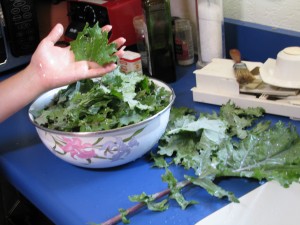
Tear into pieces and rub with oil then left them on the roof to dry. We were also playing around with zucchini chips, Swiss chard chips, and just about anything we could stick up there in the brilliant sunshine.
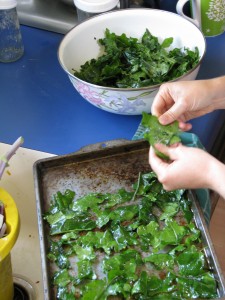
Place on drying tray The chips toasted in only about three hours. They were very crisp and dark, and had reduced in size by about a third. The first one had a wierd taste to it. The second one… and we were hooked! We crunched down several trays of them and one go. They are extremely nutritious, with calcium and folic acid among other things. We tried a more complicated recipe as well involving nutritional yeast, but it didn’t do anything special for me. The dried chard and zucchinis weren’t show-stoppers, either.
I also sauteed de-stemmed kale and it came out so creamy tasting with none of the bitterness that chard has, that it is now my favorite cooked green.
Dried kale can also be ground into a powder or flakes and used to top vegetables and grains for flavor, nutrition and color. If you use kelp flakes at all, you can substitute dried flaked kale.
Sun-Dried Kale ChipsAuthor: Diane C. KennedyRecipe type: SnackThis basic recipe is all over the Internet and produces the best resultsIngredients- At least one bunch kale
- Olive oil
- Salt (optional)
- Sunshine
Instructions- Tear kale leaves into chip-sized pieces without the midribs
- Put torn leaves into a bowl.
- Drizzle with olive oil and sprinkle with salt.
- Gently work the oil into the leaves so that each leaf is covered.
- Place on cookie tins closely but not overlapping.
- Place a piece of cheesecloth or a metal cooling rack over the kale to keep it from blowing away.
- Place cookie sheet in full sun for about three hours or longer.
- Eat!
So finally a fad that I can believe in!

